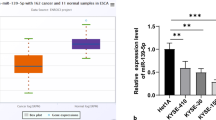Abstract
One of the important mediators of Epithelial to mesenchymal transition (EMT) is the Snail1 protein (encoded by SNAI1) which facilitates transition to mesenchymal state by transcriptionally repressing the epithelial cell marker E-cadherin. Given its central role in EMT and tumor metastasis, the cell has evolved multiple levels of regulatory mechanism at transcriptional, post-transcriptional, and post-translational level to regulate SNAI1 expression. Recently, miR-153 has been shown to regulate SNAI1 expression in hepatocellular carcinoma. The objective of the current study was to determine if SNAI1 expression in esophageal squamous cell carcinoma (ESCC) is regulated by miR-153. Metagenomic analysis of The Cancer Genome Atlas (TCGA) data identified an inverse correlation between miR-153 and SNAI1 expression in ESCC. Our study showed that the expression of miR-153 was noticeably downregulated in the ESCC cell line investigated and tissues, compared with normal esophageal epithelial cells and matched adjacent non-tumorous esophageal tissue. We demonstrated that miR-153 downregulated Snail expression by directly targeting the 3′-untranslated region (3′UTR) of SNAI1, which could be rescued by the use of miR-153 mimic and antagomir in ESCC cell line and normal esophageal epithelial cells, respectively. MiR-153 mimic inhibited the migration and invasion ability of ESCC cells whereas miR-153 antagomir promoted migration and invasion of normal esophageal epithelial cell line. Finally, overexpression of miR-153 in the ESCC cell line significantly attenuated experimental lung metastasis as assessed by tail vein injection in xenograft assay. Cumulatively, our data indicate that suppression of miR-153 dictates SNAI1 upregulation during EMT and metastatic progression of ESCC.





Similar content being viewed by others

References
Siegel R, Naishadham D, Jemal A. Cancer statistics, 2013. CA Cancer J Clin. 2013;63:11–30.
Chen Y, Zhu SM, XL X, Zhao AN, Hu JL. Expression levels of HER2 and MRP1 are not prognostic factors of long-term survival in 829 patients with esophageal squamous cell carcinoma. Oncol Lett. 2016;11:745–52.
Sawada G, Niida A, Uchi R, et al. Genomic landscape of esophageal squamous cell carcinoma in a japanese population. Gastroenterology. 2016;150(5):1171–82. doi:10.1053/j.gastro.2016.01.035
Cunningham D, Allum WH, Stenning SP, et al. MAGIC trial participants: perioperative chemotherapy versus surgery alone for resectable gastroesophageal cancer. N Engl J Med. 2006;355:11–20.
Omloo JM, Lagarde SM, Hulscher JB, et al. Extended transthoracic resection compared with limited transhiatal resection for adenocarcinoma of the mid/distal esophagus: five-year survival of a randomized clinical trial. Ann Surg. 2007;246:992–1001.
Kuo KT, Chou TY, Hsu HS, Chen WL, Wang LS. Prognostic significance of NBS1 and snail expression in esophageal squamous cell carcinoma. Ann Surg Oncol. 2012;19(Suppl 3):S549–57.
Natsugoe S, Uchikado Y, Okumura H, et al. Snail plays a key role in E-cadherin-preserved esophageal squamous cell carcinoma. Oncol Rep. 2007;17:517–23.
Zheng H, Kang Y. Multilayer control of the EMT master regulators. Oncogene. 2014;33:1755–63.
Zheng H, Shen M, Zha YL, et al. PKD1 phosphorylation-dependent degradation of SNAIL by SCF-FBXO11 regulates epithelial-mesenchymal transition and metastasis. Cancer Cell. 2014;26:358–73.
Xia W, Ma X, Li X, et al. miR-153 inhibits epithelial-to-mesenchymal transition in hepatocellular carcinoma by targeting Snail. Oncol Rep. 2015;34:655–62.
Bartel DP. MicroRNAs: target recognition and regulatory functions. Cell. 2009;136:215–33.
Esquela-Kerscher A, Slack FJ. Oncomirs - microRNAs with a role in cancer. Nat Rev Cancer. 2006;6:259–69.
Aleckovic M, Kang Y. Regulation of cancer metastasis by cell-free miRNAs. Biochim Biophys Acta. 2015;1855:24–42.
Gaur A, Jewell DA, Liang Y, et al. Characterization of microRNA expression levels and their biological correlates in human cancer cell lines. Cancer Res. 2007;67:2456–68.
Kumar MS, Lu J, Mercer KL, Golub TR, Jacks T. Impaired microRNA processing enhances cellular transformation and tumorigenesis. Nat Genet. 2007;39:673–7.
Lu J, Getz G, Miska EA, et al. MicroRNA expression profiles classify human cancers. Nature. 2005;435:834–8.
Zhao JY, Wang F, Li Y, et al. Five miRNAs considered as molecular targets for predicting esophageal cancer. Med Sci Monit. 2015;21:3222–30.
Chen WJ, Zhang EN, Zhong ZK, et al. MicroRNA-153 expression and prognosis in non-small cell lung cancer. Int J Clin Exp Pathol. 2015;8:8671–5.
Fkih M’hamed I, Privat M, Ponelle F, Penault-Llorca F, Kenani A, Bignon YJ. Identification of miR-10b, miR-26a, miR-146a and miR-153 as potential triple-negative breast cancer biomarkers. Cell Oncol (Dordr). 2015;38:433–42.
Author information
Authors and Affiliations
Corresponding author
Ethics declarations
Conflicts of interest
None
Rights and permissions
About this article
Cite this article
Zuo, J., Wang, D., Shen, H. et al. MicroRNA-153 inhibits tumor progression in esophageal squamous cell carcinoma by targeting SNAI1 . Tumor Biol. 37, 16135–16140 (2016). https://doi.org/10.1007/s13277-016-5427-x
Received:
Accepted:
Published:
Issue Date:
DOI: https://doi.org/10.1007/s13277-016-5427-x



